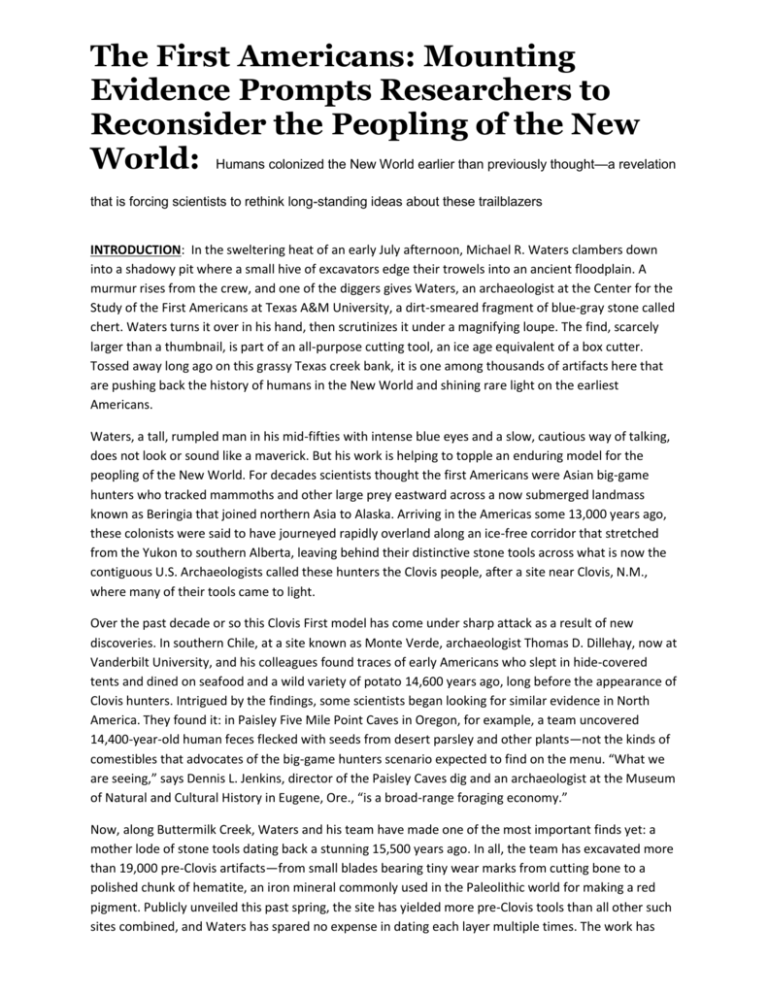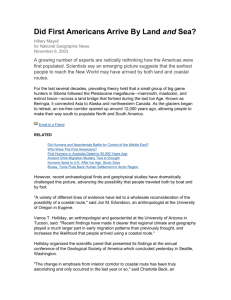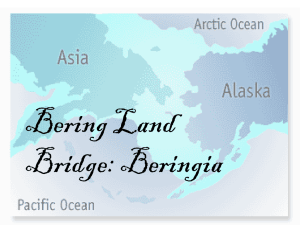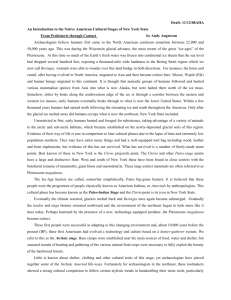The First Americans: Mounting Evidence Prompts Researchers to
advertisement

The First Americans: Mounting Evidence Prompts Researchers to Reconsider the Peopling of the New World: Humans colonized the New World earlier than previously thought—a revelation that is forcing scientists to rethink long-standing ideas about these trailblazers INTRODUCTION: In the sweltering heat of an early July afternoon, Michael R. Waters clambers down into a shadowy pit where a small hive of excavators edge their trowels into an ancient floodplain. A murmur rises from the crew, and one of the diggers gives Waters, an archaeologist at the Center for the Study of the First Americans at Texas A&M University, a dirt-smeared fragment of blue-gray stone called chert. Waters turns it over in his hand, then scrutinizes it under a magnifying loupe. The find, scarcely larger than a thumbnail, is part of an all-purpose cutting tool, an ice age equivalent of a box cutter. Tossed away long ago on this grassy Texas creek bank, it is one among thousands of artifacts here that are pushing back the history of humans in the New World and shining rare light on the earliest Americans. Waters, a tall, rumpled man in his mid-fifties with intense blue eyes and a slow, cautious way of talking, does not look or sound like a maverick. But his work is helping to topple an enduring model for the peopling of the New World. For decades scientists thought the first Americans were Asian big-game hunters who tracked mammoths and other large prey eastward across a now submerged landmass known as Beringia that joined northern Asia to Alaska. Arriving in the Americas some 13,000 years ago, these colonists were said to have journeyed rapidly overland along an ice-free corridor that stretched from the Yukon to southern Alberta, leaving behind their distinctive stone tools across what is now the contiguous U.S. Archaeologists called these hunters the Clovis people, after a site near Clovis, N.M., where many of their tools came to light. Over the past decade or so this Clovis First model has come under sharp attack as a result of new discoveries. In southern Chile, at a site known as Monte Verde, archaeologist Thomas D. Dillehay, now at Vanderbilt University, and his colleagues found traces of early Americans who slept in hide-covered tents and dined on seafood and a wild variety of potato 14,600 years ago, long before the appearance of Clovis hunters. Intrigued by the findings, some scientists began looking for similar evidence in North America. They found it: in Paisley Five Mile Point Caves in Oregon, for example, a team uncovered 14,400-year-old human feces flecked with seeds from desert parsley and other plants—not the kinds of comestibles that advocates of the big-game hunters scenario expected to find on the menu. “What we are seeing,” says Dennis L. Jenkins, director of the Paisley Caves dig and an archaeologist at the Museum of Natural and Cultural History in Eugene, Ore., “is a broad-range foraging economy.” Now, along Buttermilk Creek, Waters and his team have made one of the most important finds yet: a mother lode of stone tools dating back a stunning 15,500 years ago. In all, the team has excavated more than 19,000 pre-Clovis artifacts—from small blades bearing tiny wear marks from cutting bone to a polished chunk of hematite, an iron mineral commonly used in the Paleolithic world for making a red pigment. Publicly unveiled this past spring, the site has yielded more pre-Clovis tools than all other such sites combined, and Waters has spared no expense in dating each layer multiple times. The work has impressed many experts. “It is easily the best evidence for pre-Clovis in North America,” says Vance T. Holliday, an anthropologist and geoscientist at the University of Arizona. Energized by such finds, archaeologists are now testing new models for the peopling of the New World. Drawing on evidence from a range of sciences—from genetics to geology—they are searching for answers to a host of pressing questions: Where did the earliest Americans come from more than 15,500 years ago? When exactly did they arrive, and what route did they take into the New World? For the first time in decades there is a heady whiff of discovery in the air. “We are now addressing the big issues,” says James M. Adovasio, an archaeologist at Mercyhurst College. “We are looking at the circumstances of the dispersal of humans into the last great habitat on the planet.” Genetic Trails The peopling of the new world, from the blustery cold of the Arctic to the sultry heat of the Amazon and the stormy winds of Tierra del Fuego, remains one of humanity’s greatest achievements, a feat of endurance and adaptation not to be equaled, in the view of the famous 20th-century French archaeologist François Bordes, “until man lands on a planet belonging to another star.” Yet archaeologists have long struggled to uncover the beginnings of this transcontinental adventure, given the daunting task of locating the early campsites of a tiny population of highly mobile hunters and gatherers in the vast northern wildernesses of North America and Asia. Over the past decade, however, geneticists have taken the search for the first Americans to the molecular level, finding new clues to where they hailed from and when they left their homeland in the DNA of indigenous peoples. In more than a dozen studies geneticists examined modern and ancient DNA samples from Native Americans, looking for telltale genetic mutations or markers that define major human lineages known as haplogroups. They found that native peoples in the Americas stemmed from four major founding maternal haplogroups—A, B, C and D—and two major founding paternal haplogroups—C and Q. To find the probable source of these haplogroups, the teams then searched for human populations in the Old World whose genetic diversity encompassed all the lineages. Only the modern inhabitants of southern Siberia, from the Altai Mountains in the west to the Amur River in the east, matched this genetic profile, a finding that strongly indicates that the ancestors of the first Americans came from an East Asian homeland. This evidence confirmed what most archaeologists suspected about the location of this homeland. It also strongly suggested that the timing proposed in the Clovis First scenario was wrong. Geneticists now calculate, based on mutation rates in human DNA, that the ancestors of the Native Americans parted from their kin in their East Asian homeland sometime between 25,000 and 15,000 years ago—a difficult time for a great northern migration. Huge glaciers capped the mountain valleys of northeastern Asia, at the same time massive ice sheets mantled most of Canada, New England and several northern states. Indeed, reconstructions of past climate based on data preserved in ice cores from Greenland and on measurements of past global sea levels show that these ice sheets reached their maximum extent in the last glacial period between at least 22,000 and 19,000 years ago. “But these folks were extraordinarily adept at moving over the landscape,” says David Meltzer, an archaeologist at Southern Methodist University. “Their entire existence—and the existence of everyone they knew and the existence of their ancestors—was about adapting. They had a toolbox of tactics and strategies.” Dressed in warm, tailored hide garments stitched together with sinew and bone needles and armed with an expert knowledge of nature, the ancestors of the Paleo-Americans entered an Arctic world without parallel today. The ice sheets in northern Europe and North America had locked up vast quantities of water, lowering sea level by more than 100 meters and exposing the continental shelves of northeastern Asia and Alaska. These newly revealed lands, together with adjacent regions in Siberia, Alaska and northern Canada, formed a landmass that joined the Old World seamlessly to the New. Known today as Beringia, this landmass would have made a welcoming way station for pre-Clovis migrants. The air masses that swept over it were so dry they brought little snowfall, preventing the growth of ice sheets. As a result, grasses, sedges and other cold-adapted plants thrived there, as shown by plant remains found preserved under a layer of volcanic ash in northwestern Alaska and in the frozen intestines of large herbivores that once grazed in Beringia. These plants formed an arid tundragrassland, and there woolly mammoths weighing as much as nine tons grazed, as did giant ground sloths, steppe bison, musk ox and caribou. Genetic studies of modern Steller’s sea lion populations suggest that this sea mammal likely hauled out on the rocks along Beringia’s island-studded south shore. So the migrants may have had their pick not only of terrestrial mammals but also of seafaring ones. Received wisdom holds that the trailblazers hurried across Beringia to reach warmer, more hospitable lands. Some researchers, however, think the journey could have been a more leisurely affair. The major genetic lineages of Native Americans possess many widespread founding haplotypes—combinations of closely linked DNA sequences on individual chromosomes that are often inherited together—that their closest Asian kin lack. This suggests the earliest Americans paused somewhere en route to the New World, evolving in isolation for thousands of years before entering the Americas. The most likely spot for this genetic incubator is Beringia. There the migrants could conceivably have been cut off from their Asian kin as the climate cooled some 22,000 years ago, forcing Siberian bands to retreat south. Whether the migrants cooled their heels in Beringia, however, or somewhere else in northeastern Asia, people eventually began striking off farther east and south. A warming trend began slowly shrinking North America’s ice sheets some 19,000 years ago, gradually creating two passable routes to the south and opening the possibility of multiple early migrations. According to several studies conducted over the past decade on the geographic distribution of genetic diversity in modern indigenous Americans, the earliest of these migrants started colonizing the New World between 18,000 and 15,000 years ago—a date that fits well with emerging archaeological evidence of pre-Clovis colonists. “At some point, these migrants surveyed the landscape and realized for the first time that smoke from all the other campfires was behind them, and ahead there was no smoke.” Adovasio reflects. “And at that moment, they were literally strangers in a strange land.” A Coastal Route Archaeologists take up the tale of the earliest Americans as these travelers pushed southward, exploring a wilderness untouched by humans. In an office decorated with prints and pictures of sharks and a poster of a traditional Chumash wood canoe, Jon M. Erlandson, an archaeologist at the University of Oregon, mulls over new evidence of their journey. Reed-thin, tousled and in his mid-fifties, Erlandson has spent much of his career digging at sites along the coast of California, becoming one of the foremost proponents of what is often called the coastal route theory. Whereas supporters of the Clovis First model envisioned humans reaching the Americas by trekking overland, Erlandson thinks the earliest travelers arrived by sea, paddling small boats from East Asia to southern Beringia and down the western coast of the Americas. Now he and his colleague Todd J. Braje of San Diego State University have uncovered key new evidence of ancient mariners who set out in East Asia and ended their journey in Chile. Scientists first began thinking about this coastal route in the late 1970s, when archaeologist Knut Fladmark, now a professor emeritus at Simon Fraser University in British Columbia, started examining geologic and pollen records to reconstruct ancient environments along Canada’s western coast. At the time, most experts believed that the entire northwestern coast lay under thick ice until the end of the last glacial period. Analyses published in the 1960s and 1970s of ancient pollen from coastal bogs, however, showed that a coniferous forest thrived on Washington’s Olympic Peninsula 13,000 years ago and that other green refugia dotted the coast. Early humans camping in these spots, Fladmark concluded, could have fueled up on seafood, from shellfish to migrating pink salmon. They may also have hunted waterfowl migrating along the Pacific flyway, as well as caribou and other hardy land animals grazing in the larger refugia. Archaeologists now know that much of the British Columbian coast was free of ice at least 16,000 years ago. Although they have yet to find any preserved boats in early American coastal sites, many researchers think such watercraft were probably available to these wayfarers: at least 45,000 years ago humans voyaged and island-hopped all the way from Asia to Australia. Traveling by water down the western coast of the New World would have been easier in many respects than trekking overland. “It’s an environment that’s relatively similar along a north-south transect, which makes it a path of least resistance,” says Quentin Mackie, an archaeologist at the University of Victoria in British Columbia. Still, finding campsites of early mariners has proved a tall order for scientists. As the ice sheets of the last glacial period thawed, the meltwater raised sea level, drowning ancient coastlines under meters of water. Last March, however, Erlandson and Braje detailed in the journal Science striking evidence of early seafarers at a newly discovered site on Santa Rosa Island located just off the southern California coast. Nearly 12,000 years ago Paleo-American sailors crossed 10 kilometers of open water to reach Santa Rosa, a journey that would have required a boat. The newly discovered site, known as CA-SRI-512W, lies near the mouth of an inland canyon and close to what might have been an ancient marsh. Erlandson and his team found human refuse buried in the sediments, including bird bones and charcoal the researchers radiocarbon-dated to 11,800 years ago. Early coastal hunters had dined there on waterfowl and seabirds such as Canada geese and cormorants, as well as on pinnipeds, a group that encompasses seals and sea lions. The hunters also left behind traces of a distinctive technology: more than 50 dainty stemmed points that looked in outline like little brown Christmas trees. Such points may have tipped darts for hunting birds or small marine mammals. “They are just extremely thin and extremely well made,” Erlandson says. Overall, their design and manufacture seemed very unlike the long, furrowed and sturdy-looking Clovis spearpoints used by biggame hunters on the mainland. Curious about the origin of this coastal technology, Erlandson and Braje scoured published archaeological reports on other sites for clues. They discovered that excavators had dug up very similar stemmed points at ancient sites scattered around the northern rim of the Pacific Ocean. The earliest came from East Asia—the Korean peninsula, Japan and the Russian Far East—and all dated to around 15,000 years ago. Moreover, the farther one traveled away from there, the younger these weapons were, with 14,000-year-old stemmed points in Oregon and 12,000-year-old points on the Channel Islands, in Baja California and along coastal South America. Erlandson shakes his head in wonderment. “Some of the point assemblages in Japan are really similar to the ones in the Channel Islands,” he says. Erlandson and Braje now think this trail of technology marks out an early migration route along the northern Pacific Rim, a coastal highway loaded with food. Kelp, for example, flourishes in the cold, nutrient-rich waters there, forming coastal marine forests that harbor species ranging from rockfish to abalone to sea otters. Such marine forests would likely have thrived along Beringia’s southern coast even during the last glacial period. Studies of ocean temperature some 18,000 years ago suggest that sea ice formed only in winter along Beringia’s southern coast, and this seasonal deep freeze would not have eradicated the great marine forests. Kelp can survive under sea ice in a state akin to suspended animation for long months at a time, growing rapidly again when summer arrives and creating an abundant marine habitat. “And it’s not just kelp that would have facilitated a coastal migration,” Erlandson says. “There’s an enormous amount of other resources in marine estuaries and in salmon streams.” Indeed, edible species along the route today number in the hundreds, from cetaceans to seaweed. Even so, Paleo-Americans exploring this rich coastal world were unlikely to have raced southward. Indeed, some researchers think they may have moved just a kilometer or so a year, as the migrants gradually expanded the southern boundaries of their hunting and gathering territory. “This wasn’t a sprint down the coast,” Erlandson concludes. “You had to have marriage partners because you were moving into unpopulated lands. So you had to maintain connections with people behind you.” An Inland Corridor The western coast of the Americas was not the only available route for early colonists. Over the past five years a team of earth scientists and dating experts led by Kennedy Munyikwa, a geologist at Athabasca University in Alberta, has been reexamining another potential passageway, one that was widely championed by supporters of the Clovis First theory but that later fell out of favor after the discovery of pre-Clovis people at the site of Monte Verde near the Chilean coast. Known as the ice-free corridor, this midcontinental route formed after North America’s largest ice sheet, the Laurentide, began retreating eastward, separating from the Cordilleran ice sheet that blanketed the west, and after vast glacial lakes blocking the passageway drained, leaving dry land. The resulting corridor ran along the eastern flanks of the Rockies and extended nearly 1,900 kilometers, from Alaska to the lower 48 states. The renewed interest in this route stems from new dates on the opening of the corridor that Munyikwa and his colleagues published in June in the journal Quaternary Geochronology. In the 1980s researchers at the Geological Survey of Canada dated its opening by radiocarbon-testing plant remains preserved in sediments along the route. Their findings indicated that the two colossal ice sheets parted company and that the glacial lakes drained around 13,000 years ago. This time frame fit well with the Clovis First scenario, although it ruled out the corridor as a migration route for earlier people. Yet as Munyikwa examined these early studies for a project on ancient environment change, he saw serious problems. The radiocarbon dates were few in number, and some were clearly unreliable. Moreover, the dating of plants determined when vegetation had finally reestablished itself in the corridor, not when the ice had actually retreated and the lakes drained. So Munyikwa and his colleagues decided to redate the opening of the ice-free corridor by a technique known as optically stimulated luminescence (OSL). The team focused on a section of the corridor in northern Alberta, where large sand dunes—some exceeding 10 meters in height—had formed from windblown sediments after the Laurentide ice sheet retreated. To obtain samples for dating, Munyikwa and his team cut pits into the tallest dunes in these fields. Then they hammered black plastic pipes horizontally into the walls of these pits. Capped on one end, the pipes filled with sand that had not been exposed to sunlight since the dunes accumulated. Next the team dated each sample by the OSL method, measuring the amount of energy from environmental radiation trapped in minerals such as feldspar in the samples. The results showed that the sand dunes formed between 14,000 and 15,000 years ago, a range that likely constitutes a minimum age for the opening of the corridor, Munyikwa says, because “it’s possible that the dunes formed 1,000 years after the ice went away.” Moreover, the corridor in northern Alberta stretched at least 400 kilometers across at this time and likely cradled few if any large meltwater lakes. The sand that accumulated in dunes, Munyikwa points out, came from dry lake bottoms. The big question now is whether the entire corridor lay open during this period, particularly the section to the north. Munyikwa thinks it did. His team recently dated sand dunes farther north, along the Alberta-Northwest Territory border, with similar results. These data, Munyikwa says, fit current thinking about the Laurentide ice sheet. The general consensus among geologists, he notes, “is that the ice sheet retreated in a northeasterly direction as a wide front, as opposed to [moving] in discrete lobes. We envisage that the deglaciated land extended to the north.” If so, explorers from Asia could have entered the corridor around 15,000 years ago, nearly 1,000 years after the route to the western coast opened. The new OSL dates, says archaeologist Jack Ives of the University of Alberta in Edmonton, will prompt a fresh look at this corridor, rekindling a major debate over migration routes. “It is often alleged, in grave error, that the corridor region has been well investigated, when in fact it is vast, and we know little about it,” Ives asserts. The oldest, broadly accepted evidence of humans in the northern corridor dates to some 12,000 years ago, but Ives thinks future archaeological surveying could well turn up much earlier sites. “I think if the coast was Highway 1, then the corridor was Highway 2,” he quips. Scoured by retreating ice and pierced by cold winds, the newly opened corridor would have seemed a formidable place to early travelers. Yet it is possible, argues Stuart J. Fiedel, an archaeologist at the Louis Berger Group in East Orange, N.J., that hunter-gatherers in Beringia decided to explore it after watching flocks of waterfowl head south in the fall and return in the spring. Food would have been scarce, Fiedel says, but the explorers may have hunted calorie-rich birds or larger game. Recent genetic data suggest that mountain sheep grazed in two refugia in the Yukon and northern British Columbia. As an insurance policy, the travelers may have taken along man’s best friend. Hunters in Siberia seem to have first domesticated wolves as early as 33,000 years ago, based on paleontological evidence. Fiedel thinks early dogs would have made invaluable hunting companions and pack animals on a journey through the corridor. In historic times, he notes, hunter-gatherers on the Great Plains placed pack saddles on dogs or hitched them to travoises to carry a variety of loads, from hides for bedding and shelter to food stores. Experiments have shown that dogs can haul about 27 kilograms, Fiedel says. Moreover, a study published in 1994 revealed that dogs carrying 13 kilograms of gear could travel as far as 27 kilometers a day, provided the temperature remained cool. If starvation threatened, the migrants could have eaten some of their dogs. Fiedel has calculated that the colonists could have reached the southern end of the corridor in four months, traveling at a modest pace of 16 kilometers a day. As they left its stony bleakness behind, they would have laid eyes for the first time on a breathtaking abundance: warm, grassy plains filled with herds of mammoths, bison and horses; marshes and lakes dotted with water-fowl; oceans brimming with fish and marine mammals. It was a land empty of human rivals, a new world of possibilities. Clovis Origins In the shady air-conditioned house that serves as the field-camp headquarters at Buttermilk Creek, Waters lifts off the lid from a black box the size of a small laptop. In the kitchen, members of his crew chat and joke as they prepare lunch, but Waters seems oblivious to the patter. He quickly scans the contents of the box, picks up first one, then another of the 20 or so pre-Clovis stone tools lying inside. Fashioned from a lustrous local chert found near Buttermilk Creek, the blades and other tools are remarkably compact and lightweight, some measuring no more than a few centimeters in length. Such a tool kit, Waters says, would have been ideal for bands of early explorers, a people constantly on the move as they probed and investigated terra incognita. In some of these tools—particularly the blades and bifaces—Waters also sees something else: a new clue to the origins of the Clovis people. Some 2,500 years after the pre-Clovis people here knapped blades and bifaces, Clovis hunters employed similar techniques across North America to make massive elongate blades, some reaching 21 centimeters or more in length. This technological continuity, Waters observes, hints strongly at a relationship between the two groups. Far from being migrants from Asia, the famous Clovis hunters may well have descended from bands such as the earliest hunters at Buttermilk Creek. “It looks as if they originated south of the ice sheet,” he remarks. What is beyond all doubt, however, is that the earliest Americans and their descendants were a resilient and resourceful people, trailblazers who settled the longest geographic expanse ever settled by humans. Braving the unknown, they adapted masterfully to a vast array of ecosystems on two continents. These early Americans deserve our admiration, says archaeologist David Anderson of the University of Tennessee. “I think they exemplify the spirit of survival and adventure that represents the very best of humanity.” This article was originally published as "The First Americans".










